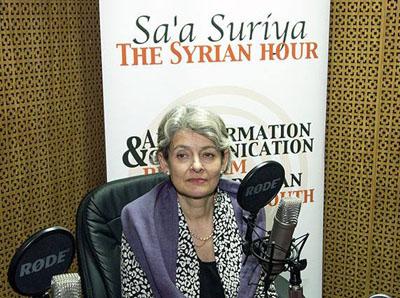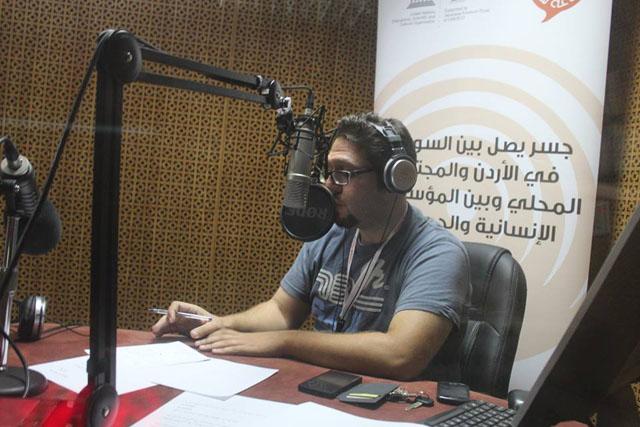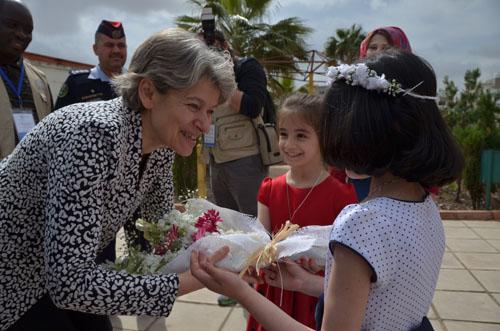You are here
Radio show offers Syrian refugees information on available services
By Muath Freij - Mar 26,2014 - Last updated at Mar 26,2014

AMMAN — Syrian refugees can learn more about the services they are entitled to in Jordan and other issues of interest to them thanks to a radio show launched by UNESCO.
Dubbed “Saa Suriya” (Syrian hour), the programme was first launched in 2012 after UNESCO noticed a lack of projects that provide information about issues and services related to refugees in the Kingdom, according to Maaly Hazzaz, UNESCO communication and information officer.
“Most projects targeting refugees were life-saving ones, covering health, education and real estate services, so we thought of a project to serve refugees by offering information,” she told The Jordan Times in a recent interview.
The programme was first broadcast on Yarmouk FM for people who live in Irbid and Mafraq in the northern region, but it only lasted for three months due to lack of funds.
Hazzaz noted that after they conducted a questionnaire survey among refugees to examine the effect of the programme, they found that a number of Syrians contacted Yarmouk FM to ask whether the show would be extended.
UNESCO was able to resume broadcasting the show for another three months in 2013 after receiving funds from UNFPA.
“After the end of the show, we used its outcomes and importance to get more funding from the government of Japan to extend the programme. Now, the project will last for one year,” she added.
The show was officially launched during the visit of UNESCO Director General Irina Bokova to Jordan earlier this month.
It will be broadcast via Farah Al Nas Radio (98.5FM) every Sunday and Tuesday at 1pm. More information is available on its Facebook page (www.facebook.com/Saa.Suriya).
Speaking at a press conference during her visit last week, Bokova noted that the radio show creates a platform for both Syrian and Jordanian youths.
“It is a modest project, but we hope that it will have a positive and huge impact on involving the youth around the idea of understanding each other [and] pursuing education,” she said.
Within this year’s project, a number of young Jordanians will take part in training courses on radio and humanitarian reporting.
“These young people will [go on] field visits to refugees to do interviews with them, and find out their questions and comments about each issue that will be discussed in the show,” Bokova noted.
Information is being collected from the government as well as international and local organisations that work with refugees.
“The show tackles several issues including education, workforce and health. This show helps refugees understand their needs and rights, [as well as] things Syrians can do and are not allowed to do,” the UNESCO chief added.
During the first five minutes of each programme, Saa Suriya broadcasts the latest services from which Syrian refugees can benefit, Hazzaz said.
Around 3,153 radios will be distributed to refugees, according to UNESCO.
“Radio is the best means of communication that can easily reach many people better than TV or newspapers,” Hazzaz added.
Bilal Khasawneh, who presents Saa Suriya on Yarmouk FM, said the programme targets Syrians who live outside the Zaatari Refugee Camp.
The show airs every Monday and Wednesday at 5pm on Yarmouk FM.
Mohammad Massad, the presenter of the programme on Farah Al Nas, noted that the local community can also benefit from the show.
The community radio station broadcasts daily to the 3 million residents of Amman, Zarqa and other governorates in the northern and southern regions of the Kingdom.
Applying the concept of media for development, the Jordanian Hashemite Fund for Human Development’s (JOHUD) Farah Al Nas Radio began broadcasting in July 2008.
It was the first community radio station in Jordan to provide people with a platform for discussion, concentrating on women’s and youth issues, according to a JOHUD statement.
Related Articles
A radio show initially conceived to benefit Syrian refugees living among host communities has also become a tool enabling Jordanians to know more about Syrians’ plight and interact with them.
Tackling the problem of Syrian refugees in isolation from the development issues of host countries is not a good strategy, according to UNESCO Director General Irina Bokova.
AMMAN — The efforts of local community radio station Farah Al Nas in tackling political, social and developmental issues related to youth an



















